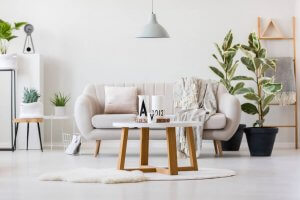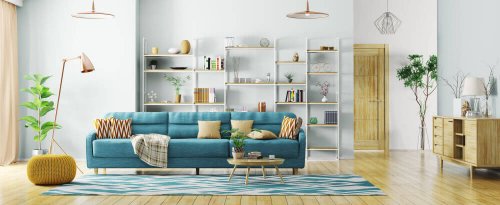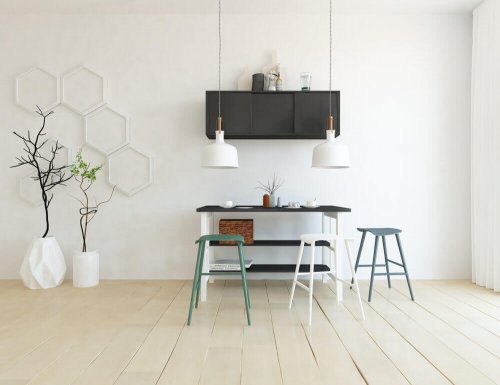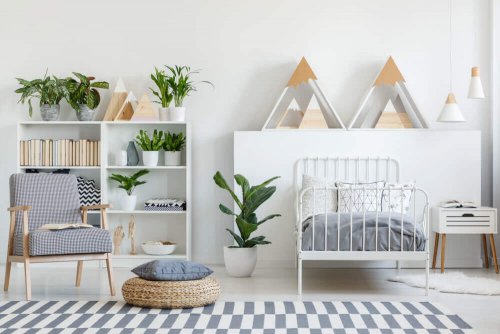The Organic Balance of Scandinavian Design

Would you like to decorate your home more creatively while ensuring complete harmony? Then it’s time to apply the organic balance of Scandinavian design, where essential elements are incorporated to achieve a natural look.
To do this, you’ll have to resort to certain decorative resources that you probably never imagined you’d use in your home. In this sense, you’re going to use wood, plants, and color combinations to get a Nordic and fresh look.
Nowadays, people tend to use the same urban decorative resources – those featured in magazines and commercial establishments. However, there’s another solution that might interest you.
What’s Scandinavian design?

This decorative style reminds us of very spacious, fresh, and cool spaces full of light. It completely rejects the dominance of warm colors and any exotic element. However, it’s similar to the Mediterranean decorative style in some ways.
The inspiration comes from northern Europe. In other words, from countries that are connected to the Baltic Sea. These places have similar traditional decor characteristics, especially the houses that are located in rural and remote areas.
What sensations do you feel in a Scandinavian design environment? Mainly, you’ll perceive coolness, freshness, and hygiene. There’s no discomfort or excessive overloading. Instead, the spaces feel open.
Scandinavian design allows you to make atmospheres more translucent.
Wood floors

To achieve the organic concept of Scandinavian design, you must consider that the floors are the benchmarks that will provide naturalness. Therefore, it’s imperative to have wood floors.
This is because they can establish a contrast with other tones, whether dark or light. It’s advisable to use lighter tones. This is the best way to achieve a Scandinavian design and, therefore, provide greater dynamism.
You can leave most of the floor uncovered. But if you decide to use a rug, make sure it’s either small or medium. And ensure that the rug consists of neutral tones so it doesn’t draw the focus away from the floor.
Color combinations in Scandinavian design

You’re probably wondering what colors should predominate in these environments. Fundamentally, you must achieve balance and harmony. Otherwise, you’ll stray away from Scandinavian design.
- The floors, which should be wooden, offer an earthy color that resembles the soil. They’re a representation of nature. Likewise, they’ll offer a natural and organic character, as it’ll seem that the furniture is growing out of the floors.
- White, dark blue, light blue, gray, black, or purple furniture goes well with wood floors. The use of these colors can help ensure balance in the environment.
- What happens if you introduce warm colors? Their presence should be simple and basic, for example, salmon. It can appear in a piece of furniture (armchair or sofa) or some other element… but only once.
- Of course, earthy colors are a good choice. They go very well with darker tones.
Plants, a key component

If you want to achieve an organic and natural environment, you have to add plants. They’ll be your main resource to add freshness. They’re a part of nature that make environments look healthy and clean.
You don’t have to overdo it with the plants. Just make sure they make an appearance! They go perfectly well with wood floors, beams, or other furniture.
How to achieve balance

First and foremost, try to use basic and essential furniture. It isn’t a good idea to fill rooms with furniture from different categories, formats, and designs. The designs must be simple.
The goal is to achieve complete harmony, peace, and stability. This is the way to create a decorative balance.
https://midecoracion.com/casas/el-equilibrio-organico-de-estilo-escandinavo/
Would you like to decorate your home more creatively while ensuring complete harmony? Then it’s time to apply the organic balance of Scandinavian design, where essential elements are incorporated to achieve a natural look.
To do this, you’ll have to resort to certain decorative resources that you probably never imagined you’d use in your home. In this sense, you’re going to use wood, plants, and color combinations to get a Nordic and fresh look.
Nowadays, people tend to use the same urban decorative resources – those featured in magazines and commercial establishments. However, there’s another solution that might interest you.
What’s Scandinavian design?

This decorative style reminds us of very spacious, fresh, and cool spaces full of light. It completely rejects the dominance of warm colors and any exotic element. However, it’s similar to the Mediterranean decorative style in some ways.
The inspiration comes from northern Europe. In other words, from countries that are connected to the Baltic Sea. These places have similar traditional decor characteristics, especially the houses that are located in rural and remote areas.
What sensations do you feel in a Scandinavian design environment? Mainly, you’ll perceive coolness, freshness, and hygiene. There’s no discomfort or excessive overloading. Instead, the spaces feel open.
Scandinavian design allows you to make atmospheres more translucent.
Wood floors

To achieve the organic concept of Scandinavian design, you must consider that the floors are the benchmarks that will provide naturalness. Therefore, it’s imperative to have wood floors.
This is because they can establish a contrast with other tones, whether dark or light. It’s advisable to use lighter tones. This is the best way to achieve a Scandinavian design and, therefore, provide greater dynamism.
You can leave most of the floor uncovered. But if you decide to use a rug, make sure it’s either small or medium. And ensure that the rug consists of neutral tones so it doesn’t draw the focus away from the floor.
Color combinations in Scandinavian design

You’re probably wondering what colors should predominate in these environments. Fundamentally, you must achieve balance and harmony. Otherwise, you’ll stray away from Scandinavian design.
- The floors, which should be wooden, offer an earthy color that resembles the soil. They’re a representation of nature. Likewise, they’ll offer a natural and organic character, as it’ll seem that the furniture is growing out of the floors.
- White, dark blue, light blue, gray, black, or purple furniture goes well with wood floors. The use of these colors can help ensure balance in the environment.
- What happens if you introduce warm colors? Their presence should be simple and basic, for example, salmon. It can appear in a piece of furniture (armchair or sofa) or some other element… but only once.
- Of course, earthy colors are a good choice. They go very well with darker tones.
Plants, a key component

If you want to achieve an organic and natural environment, you have to add plants. They’ll be your main resource to add freshness. They’re a part of nature that make environments look healthy and clean.
You don’t have to overdo it with the plants. Just make sure they make an appearance! They go perfectly well with wood floors, beams, or other furniture.
How to achieve balance

First and foremost, try to use basic and essential furniture. It isn’t a good idea to fill rooms with furniture from different categories, formats, and designs. The designs must be simple.
The goal is to achieve complete harmony, peace, and stability. This is the way to create a decorative balance.
https://midecoracion.com/casas/el-equilibrio-organico-de-estilo-escandinavo/
All cited sources were thoroughly reviewed by our team to ensure their quality, reliability, currency, and validity. The bibliography of this article was considered reliable and of academic or scientific accuracy.
- Gutiérrez Valdemoro, Juan: Decoración y ambientación en habitaciones y zonas comunes en alojamientos, Paraninfo, 2016.







